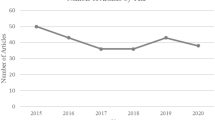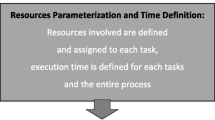Abstract
This study investigates the process of operating room scheduling at a surgery department in a Midwestern hospital. A comprehensive process map was developed to depict the existing scheduling process and enhance understanding of the complexity of hospital operations. Close examination of the process map suggests several obstacles and bottlenecks that impede operation efficiency of the investigated surgery department. The implications for IS research are also discussed.



Similar content being viewed by others
References
Aanestad M, Jensen TB. Building nation-wide information infrastructures in healthcare through modular implementation strategies. J Strateg Inf Syst. 2011;20(2):161–76.
American Hospital Association. Chartbook: trends affecting hospitals and health systems. 2012. http://www.aha.org/research/reports/tw/chartbook/index.shtml. Accessed 21 Oct 2012.
Barkhi R. The effects of decision guidance and problem modeling on group decision-making. J Manag Inf Syst. 2002;18(3):259–82.
Berenson RA, Ginsburg PB, May JH. Hospital-physician relations: cooperation, competition, or separation? Health Aff. 2007;26(1):w31–43.
Beretta S. Unleashing the integration potential of ERP systems: the role of process-based performance measurement systems. Bus Process Manag J. 2002;8(3):254–77.
Carlson G, Greeley H. Is the relationship between your hospital and your medical staff sustainable? J Health Manag. 2010;55(3):158–73.
Caron JR, Jarvenpaa SL, Stoddard DB. Business reengineering at CIGNA corporation: experiences and lessons learned from the first five years. MIS Q. 1994;18(3):233–50.
Chiasson MW, Davidson E. Pushing the contextual envelope: developing and diffusing IS theory for health information. Inf Organ. 2004;14(3):155–88.
Compeau DR, Higgins CA, Huff S. Social cognitive theory and Individual reactions to computing technology: a longitudinal study. MIS Q. 1999;23(2):145–58.
Compeau DR, Higgins CA. Computer self-efficacy: development of a measure and initial test. MIS Q. 1995;19(2):189–211.
Davis FD. Perceived usefulness, perceived ease of use, and user acceptance of information technology. MIS Q. 1989;13(3):319–39.
Deming WE. Out of the crisis. Cambridge: Cambridge University Press; 1982.
Dennis AR. Information exchange and use in group decision making: you can lead a group to information, but you can’t make it think. MIS Q. 1996;20(4):433–57.
Dennis AR, Hilmer KM, Taylor NJ. Information exchange and use in GSS and verbal group decision making: effects of minority. J Manag Inf Syst. 1998;14(3):61–88.
Fichman RG, Kohli R, Krishnan R. The role of information systems in healthcare: current research and future trends. Inf Syst Res. 2011;22(3):419–28.
Goh JM, Gao G, Agarwal R. Evolving work routines: adaptive routinization of information technology in healthcare. Inf Syst Res. 2011;22(3):565–85.
Goldsmith J. Hospitals and physicians: not a pretty picture. Health Aff. 2007;26(1):w72–5.
Goodhue DL, Wybo MD, Kirsch LJ. The impact of data integration on the costs and benefits of information systems. MIS Q. 1992;16(3):293–311.
Grote J, Mango J, Sutaria S. Transforming U.S. hospitals. McKinsey Q. 2007. https://www.mckinseyQ.com/Transforming_US_hospitals_1937. Accessed 21 Oct 2012.
Hasselbring W. Information system integration. Commun ACM. 2000;43(6):32–8.
He J, Freeman L. Understanding the formation of general computer self-efficacy. Commun Assoc Inf Syst. 2010;26(12):225–44.
Holm CE, Burns LR. The future of physician-health system integration. J Health Manag. 2000;45(6):356–8.
Ibold K. Ailing hospital industry. Fla Trend. 1999;42(4):26.
Jensen TB, Aanestad M. Hospitality and hostility in hospitals: a case study of an EPR adoption among surgeons. Eur J Inf Syst. 2007;16(6):672–80.
Juran JM. Juran on planning for quality. New York: Free Press; 1988.
Karahanna E, Straub DW. The psychological origins of perceived usefulness and ease of use. Inf Manag. 1999;35(4):237–50.
Kettinger WJ, Teng JTC, Guha S. Business process change: a study of methodologies, techniques, and tools. MIS Q. 1997;21(1):55–80.
Kim BO. Business process reengineering: building a cross-functional information architecture. J Syst Manag. 1994;45(12):30–5.
Kolodner RM, Cohn SP, Friedman CP. Health information technology: strategic initiatives, real progress. Health Aff. 2008;27:w391–5.
Li L, Xu L, Jeng HA, Naik D, Allen T, Frontini M. Creation of environmental health information system for public health service: a pilot study. Inf Sys Front. 2008;10(5):531–42.
Mango PD, Shapiro LA. Hospitals get serious about operations. McKinsey Q. 2001;2001(2):74–85.
Miller RH. Health system integration: a means to an end. Health Aff. 1996;15(2):92–106.
Muscatello JR, Small MH, Chen IJ. Implementing enterprise resource planning (ERP) systems in small and midsize manufacturing firms. Int J Oper Prod Manag. 2003;23(8):850–71.
New Jersey commission on rationalizing health care resources, final report. 2008. http://www.nj.gov/health/rhc/finalreport/index.shtml. Accessed 21 Oct 2012.
Newell S. Special section on healthcare information systems. J Strateg Inf Syst. 2011;20(2):158–60.
Ngai EWT, Poon JKL, Suk FFC, Ng CC. Design of an RFID-based healthcare management system using an information system design theory. Inf Syst Front. 2009;11(4):405–17.
Oborn E, Barrett M, Davidson E. Unity in diversity: electronic patient record use in multidisciplinary practice. Inf Syst Res. 2011;22(3):547–56.
Ogles BM, Trout SC, Gillespie DK, Penkert KS. Managed care as a platform for cross-system integration. J Behav Health Serv Res. 1998;25(3):252–68.
Payton FC, Pare G, Le Rouge CM, Reddy M. Health care IT: process, people, patients and interdisciplinary considerations. J Assoc Inf Syst. 2011;12(2/3):i–xiii.
Pinsonneault A, Kraemer KL. Middle management downsizing: an empirical investigation of the impact of information technology. Manag Sci. 1997;43(5):659–79.
Raymond L, Uwizeyemungu S. A profile of ERP adoption in manufacturing SMEs. J Enterp Inf Manag. 2007;20(4):487–502.
Sasaki H. A computing theory for collaborative and transparent decision making under time constraint. Inf Syst Front. 2011;13(2):207–20.
Taylor FW. The principles of scientific management. New York: Harper and Brothers; 1911.
Turban E, Liang T, Wu SPJ. A framework for adopting collaboration 2.0 tools for virtual group decision making. Group Decis Negot. 2011;20(2):137–54.
Venkatesh V, Morris MG, Davis GB, Davis FD. User acceptance of information technology: toward a unified view. MIS Q. 2003;27(3):425–78.
Venkatesh V, Zhang X, Sykes TA. “Doctors do too little technology”: a longitudinal field study of an electronic healthcare system implementation. Inf Syst Res. 2011;22(3):523–46.
Wan TH, Wang BL. Integrated healthcare networks’ performance: a growth curve modeling approach. Health Care Manag Sci. 2003;6(2):117–24.
Wilson EV. Editorial statement: information systems and healthcare department. Commun Assoc Inf Syst. 2004;13(27):456–8.
Zimmerman RS. Hospital capacity, productivity, and patient safety—it all flows together. Front Health Serv Manag. 2004;20(4):33–8.
Conflict of interest
The authors declare that they have no conflict of interest.
Author information
Authors and Affiliations
Corresponding author
Rights and permissions
About this article
Cite this article
Chandra, C., He, J., Liu, Z. et al. Some promising areas for IS research in the hospital industry: implications from a case study of operating room scheduling. Health Technol. 3, 65–72 (2013). https://doi.org/10.1007/s12553-013-0042-y
Received:
Accepted:
Published:
Issue Date:
DOI: https://doi.org/10.1007/s12553-013-0042-y




